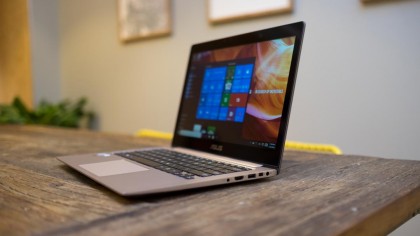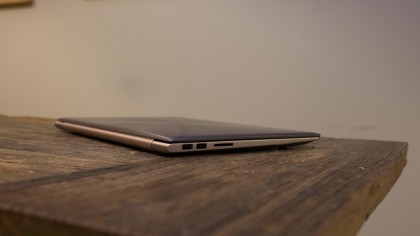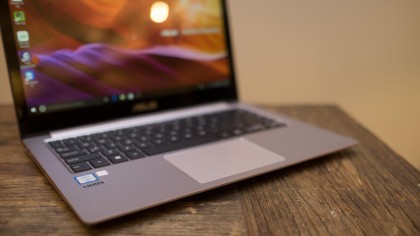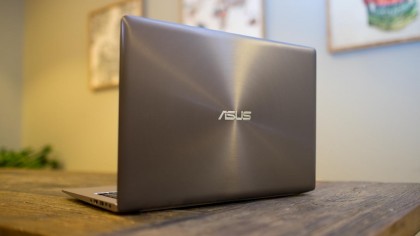Why you can trust TechRadar
The unit we're testing comes with the standard i7-6500U chip from Intel's new Skylake range and a pleasing 12GB of RAM. It's got a reasonably sized 256GB SATA SSD, which is more than enough space for anything except video and photo-editing – and perhaps gaming. But then the graphics chip is a bog-standard baked-in Intel 520, so you shouldn't expect anything wonderful from this.

Specifications
Here is the Asus UX303UA configuration sent to techradar for review:
- CPU: 2.5GHz Intel Core i7-6500U
- Graphics: Intel HD Graphics 520
- RAM: 12GB (8GB DDR3L 1600MHz SDRAM, on-board Memory 4GB)
- Screen: 13.3-inch IPS FHD (1,920 x 1,080)
- Storage: 256GB SSD
- Ports: 3 x USB 3.0 ports, HDMI, 1 x mini-DisplayPort, Headphone / microphone combo jack, SD / SDHC card reader, Ethernet RJ-45 adaptor, mini-HDMI adaptor
- Connectivity: 802.11ac and Bluetooth 4.0 (on WLAN+ BT combo card)
- Camera: HD Webcam (front-facing)
- Weight: 1.45 kg
- Size: 323 x 223 x 19.2mm (W x D x H)
Overall, that's a fine mid-end setup. The SSD is welcome (but can be swapped out for larger HDDs or hybrid drives), and the extra RAM will smooth out most operations. That's also a nice array of full-size ports (especially compared to the UX305's slightly small selection of mini-ports.)

The slow shedding of the UX303's weight is approaching MacBook Air standards (1.35kg for the 13-inch model) – this 1.45kg is just pleasant enough to carry in the hand. It is however heavier than the UX305 (1.18kg) and the 12-inch MacBook (0.92kg), as well as being 50% thicker than both the UX305 (12.3cm) and the MacBook (13.1cm)
Performance and features
On everyday tasks, the Asus is pretty speedy, and we didn't notice any problems with several tabs open, even those running relatively intensive processes. Whether playing 1080p video or tackling online games, the processor didn't struggle at all – as might be expected compared to other mobile CPUs.
Powering up was very swift – presumably thanks to that SSD again.
Benchmarks
Here's how the Asus Zenbook UX303 performed in our suite of benchmark tests:
- 3DMark: Cloud Gate: 5619; Sky Diver: 3416; Fire Strike: 804
- Cinebench: CPU: 287 points; Graphics: 35.57 fps
- PCMark 8 Home Test: 3236 points
- PCMark 8 Battery Life: 5 hours 20 minutes
Those are really not bad benchmarks for an Ultrabook – more than matching the latest Dell XPS 13 in most regards, and exceeding it comfortably when it comes to running graphical programs and on the PCMark 8 Home Test.
Admittedly, that Cloud Gate score is way sub-10,000, Sky Diver's below 5,000 and Fire Strike is sub-3,000, so it's not going to sparkle at intensive 3D gaming, nor for any graphics-intensive applications – but it will run many modern games at 30 fps. The Cinebench scores corroborate that, showing it can cope with intensive 1080p content at around 30 fps.

Battery win
That battery life score, thankfully, is good and healthy. Anything above five hours is good by our reckoning and it didn't get hot or noisy at all in that time. In our anecdotal tests, it lasted a couple of hours longer, which is pretty fine for an Ultrabook, if nothing spectacular.
Notably, it's better than the Dell XPS 13 which came in at under five hours. The UX305 performed much better in terms of battery life – clocking in at six-and-a-half hours – but was much worse on all other metrics. And the MacBook was more of the same, with an even better battery life and even worse performance.
However, it can't really be said that the change to Skylake has revolutionised the performance of the UX303. This is a minor shuffle forward rather than a great leap.
Full HD delight
The Zenbook UX303UA came with a solid 1080p display. If you want a lower price model, you can plump for a 1366 x 768 display, and if you want more sharpness, an IPS QHD+ model is available with a delightful 3200 x 1800 display. Running behind is a fixed Intel HD Graphics 520, which should help modern games just about run, as those benchmarks earlier showed.

The screen itself is IPS and is 13.3-inches on the diagonal. The anti-glare finish makes it matte rather than gloss, which is great in high-light environments – and in low-light environments it looks rather lovely, even at wide viewing angles. Some of that has to be due to the colour depth, which is highly vivid and seems accurate, and some, perhaps, to the bespoke Asus Splendid tech, which automatically optimises the display for different images.
We thought that the brightness on battery power wasn't wonderful, despite a good contrast ratio – and suspected a weaker-than-welcome backlight. Then we discovered the 'Ambient Light Sensor' button, which automatically dims the screen to match the environment – though we found in general that it over-dimmed the screen, so wasn't as useful as it could be.
Bundled software
There's the usual array of bundled software with the UX303UA, with much of it being trial versions or not particularly useful. On top of the ambient light sensor, the laptop comes with a piece of software called an Eye Care Switcher – which, as far as I can tell, just dims the screen slightly. Annoyingly, it takes a few seconds to kick in.

If you're looking for cloud storage, there's a bundled Asus WebStorage app. As good as it might be (and it is priced competitively with other suppliers), we still heavily recommend a non-supplier specific storage supplier, like Google Drive, because of the ease of transferring your data and for long-term security. Dropbox, which comes installed on the machine too, is another option, though its storage policies and tech aren't as user-friendly as Google's.
Yet again, this laptop comes with Evernote, the app that doesn't know what it is. We'd uninstall it pretty quickly, unless you're already trapped in that ecosystem.

There are a couple of handy Cyberlink movie and photo editing tools, which will save you downloading something similar from SourceForge – though we always prefer the more powerful free tools. When it gets down to it, we can understand that if you want simpler tech, Cyberlink's stuff will do the job.
Asus' own AudioWizard app is also included, which is essentially a mixer with five presets for different audio effects.
